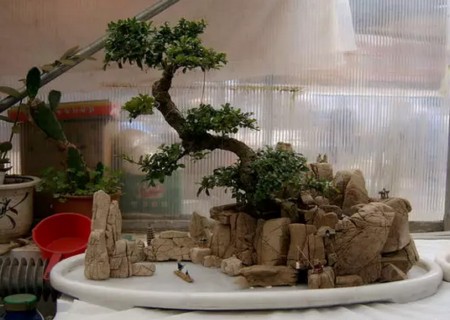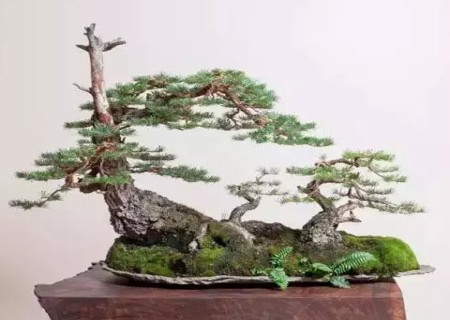Planting method of Sabina vulgaris bonsai
Cliff cypress has many ways to play; there are playing with its unique fragrance, some with its elegant shape of fairy bones, some with its millennium-old trinkets, and some with its cultural meaning of sculpture, while bonsai planting is the highest realm of playing with cedar. The tree shape of the combination of withering and prosperity, the coexistence of life and death, and distorted changes can make people feel the vicissitudes of time and the power of life. This kind of state shown by the cypress can not be surpassed by any bonsai material that has appeared in the world. The cypress is the king of root art, and the bonsai is also the king of bonsai!
In the process of digging cliff cypress, the brothers in the mountains often dig up some live materials, and some specially dig live materials to sell to bonsai middlemen. The amount of live material of Sabina vulgaris is more than that of dry material, but a large number of live materials can not take out the roots or cut off the branches and leaves, so they become the double color and white leather material in the material. But if you encounter live material with roots and leaves, it can be cultivated and survived. No matter the ecological value, the appreciation value or the market price, it can't be compared with the simple root carving.
Dig: the root is the least suitable to dig, but as long as there are two or three small red roots, there is also hope of survival, the more leaves, the better. Having roots and leaves is the first root for the survival of the cypress. If there are no roots and leaves, no matter how hard you try, it is futile.
Time: the shorter the time from picking and digging from the cliff to the soil, the better. The living tree had better be planted that night after going down the hill. If you don't plant at that time, you can put it in a warm, humid dark place, keep it moist with sprinkling water and spray, and don't soak the roots in water.
Use soil: cultivation soil must be permeable, breathable, loose mixed soil, do not use pure soil, generally add 80% of river sand. In the area of Taihang Mountain, it is best to use the coal ball which has no fire gas for a period of time after burning. The waste coal ball ash is aseptic, permeable and breathable, and has good moisturizing properties, which is very suitable for the cultivation of Sabina vulgaris. When watering, the water must seep into the soil within 2 or 3 seconds and flow out of the basin bottom.
Planting: after planting, it is best not to transplant within three years, and never transplant twice within one year. It is difficult for a cypress to take root, and the roots of a tree that has survived for two years may not necessarily grow well, so it has to be planted in a container, and after planting, the trunk is fixed on the container with a rope so that the tree cannot shake.
Moisturizing: newly planted cypress is recommended to be cultivated in greenhouse, which is the best way to improve the survival rate, which can keep moisture and control temperature. In the growing period, the basin soil can not be dry, the humidity of the environment should be kept above 70%, and the temperature is 25 to 35 degrees, which is the best time for Sabina vulgaris to take root and sprout. Pay attention to ventilation. The main purpose of moisturizing and temperature control is to keep the trunk and leaves from losing water, maintain life, and continue to take root and sprout.
Taboos on bonsai cultivation of Sabina vulgaris
1. Avoid fertilizing. Due to the high temperature in midsummer and the rapid loss of water on the leaf surface, fertilization can make the concentration of pile cells less than that of the external environment, resulting in the reverse flow of water in plant cells and the death of piles due to fertilizer damage. However, it can be sprayed with new high-fat membrane protective solution to prevent water evaporation.
2. Avoid drought. When I think of watering, I don't water it if I don't remember it. Sometimes I don't care for several days in a row. Once the leaves are found to be wilting, they quickly replenish the water, and the leaves return to normal. This is a reaction of the pile body to adapt to the environment, but for a long time, excessive transpiration will eventually make the pile body "sick" difficult to recover, dehydration and death.
3. Avoid water stains. When the ambient temperature exceeds 28 degrees, the bonsai should be protected by shade, otherwise, the amount of water obtained by the pile from the soil is much lower than that lost by transpiration, the leaf edge will burn and scorch, and the pile will die from sunburn.
4. Avoid sudden shade. Usually, in order to avoid high temperature injury, when the ambient temperature exceeds the maximum temperature of the pile, the bonsai should be moved to the relatively low temperature area with weak light to facilitate the growth of the pile, but if it is suddenly moved into the indoor or low temperature area without light, within a few days, the leaves will fall off naturally, and the pile will shrink and die quickly.
Avoid taking a bath in the afternoon. Do not spray water to the pile under the light or water into the basin at noon in hot summer, this kind of "pet" way will make the bonsai temperature suddenly lower than the ambient temperature and hurt the pile.
Time: 2019-06-03 Click:
- Prev

Illustration of the method of making tree and stone flood and drought bonsai
Tree and stone flood and drought bonsai take plants, rocks and cultivation matrix as materials, apply the creative techniques of trees and landscape bonsai respectively, combine them into scenery according to their intention, and carefully deal with the topography and landform, decorating pavilions, carts, cattle and horses, figures and other furnishings to show the waters in the basin.
- Next

Conservation conditions and techniques of Sabina vulgaris bonsai
The tree shape of the combination of withering and prosperity, the coexistence of life and death, and distorted changes can make people feel the vicissitudes of time and the power of life. This kind of state shown by the cypress can not be surpassed by any bonsai material that has appeared in the world. The cypress is the king of root art, and the bonsai is also the king of bonsai.
Related
- Fuxing push coffee new agricultural production and marketing class: lack of small-scale processing plants
- Jujube rice field leisure farm deep ploughing Yilan for five years to create a space for organic food and play
- Nongyu Farm-A trial of organic papaya for brave women with advanced technology
- Four points for attention in the prevention and control of diseases and insect pests of edible fungi
- How to add nutrient solution to Edible Fungi
- Is there any good way to control edible fungus mites?
- Open Inoculation Technology of Edible Fungi
- Is there any clever way to use fertilizer for edible fungus in winter?
- What agents are used to kill the pathogens of edible fungi in the mushroom shed?
- Rapid drying of Edible Fungi

